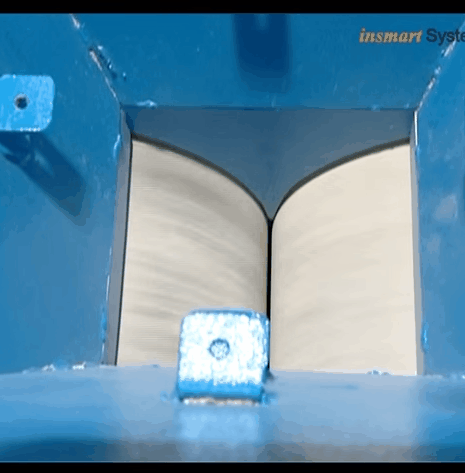Comparison between Rolls and Stamps: As the subsequent treatment of an ore determines its method of crushing, no accurate general comparison of stamps and rolls can be made. A comparison is only possible in the special cases where both methods of crushing are applicable. Wet crushing by rolls need not be considered, as it is not practised; even where the advocates of rolls wish to replace stamps by rolls for wet crushing and amalgamation, they propose that the ore should be crushed dry and then wetted down. Dry crushing by stamps is usually about one-third more expensive than wet crushing, as the capacity falls off to that extent, in spite of double discharge, assisted occasionally by currents of air given by blowers, which are designed to carry the crushed ore against the screens. The amount of slimes made is also large. Advantages in the use of rolls for dry crushing have been stated to be “ the fewness of the wearing parts, and consequent small cost of repairs; the great efficiency of the process, in that the ore escapes from the rolls immediately it is crushed, so that over-crushing is unlikely to occur, and the great capacity of rolls, effective work being constantly done, and the amount of crushing surface brought into contact with the ore per minute being very large. The prime cost of the rolls is considerably less than that of stamps of the same capacity.”
The capacity of rolls has perhaps been frequently overestimated owing to the assumption having been made, that the product of equal crushing surfaces must be the same. Thus, Curtis observes in the paper already cited:—“As an index of the capacity of Krom’s rolls, it may be stated that two sets of 26-inch (diameter) rolls, with faces 15 inches long, give rather more effective crushing surface than fifty gravitation stamps, each 8 inches in diameter, falling at the rate of ninety drops per minute. In making this calculation, the average diameter of the rolls is taken as only 24 inches, so as to allow for their gradual wearing, while their speed is taken at 100 revolutions per minute.”
Although the calculated crushing surface is as stated, it does not follow that the capacity of the two sets of machinery compared with one another is the same, since it will depend on the pressure as well as the crushing surface. No doubt the pressure at the moment of impact of a 900-lb. stamp is enormously greater than that exercised by the faces of the rolls.
On this point J. Richards, M.E., writes:—“The coefficient of (crushing) effect in such machines (as revolving rollers and reciprocating machines) is as the area of the acting surfaces, and the speed with which they approach each other. The mistake in respect of the crushing power of rollers comes from confounding their circumferential velocity with the working one— that is, with the parallel velocity at which the surfaces approach and leave each other,” that is, the velocity at right angles to the crushing surface. Richards elsewhere shows that a Blake machine in this way actually outruns a revolving roller, although its crushing face travels more slowly than the periphery of the roll. He proceeds ;—“The same principle holds good in respect to stamps, the crushing surfaces having a parallel approach, while with rotary machinery the approach is not parallel, except on an imaginary line at the centre.” As a matter of fact, the product of two pairs of rolls amounts to only about 40 to 50 per cent, of that which would be given by a fifty-stamp mill on the same ore. In the absence of exact comparative data regarding the same ore, no precise figures regarding the relative capacities can be given.
A point to be noticed is that, in machines which act by pressure applied on the principle of the lever, such as reciprocating-jaw crushers or rolls, the whole force necessary to crush the lumps of quartz is transmitted to the fulcrum, this fulcrum being represented in the case of rolls by the bearing surface at the axle. The consequence is that the frame must be made very strong and heavy, and the axle bearings attended to with great care, if rapid wear is to be avoided.
